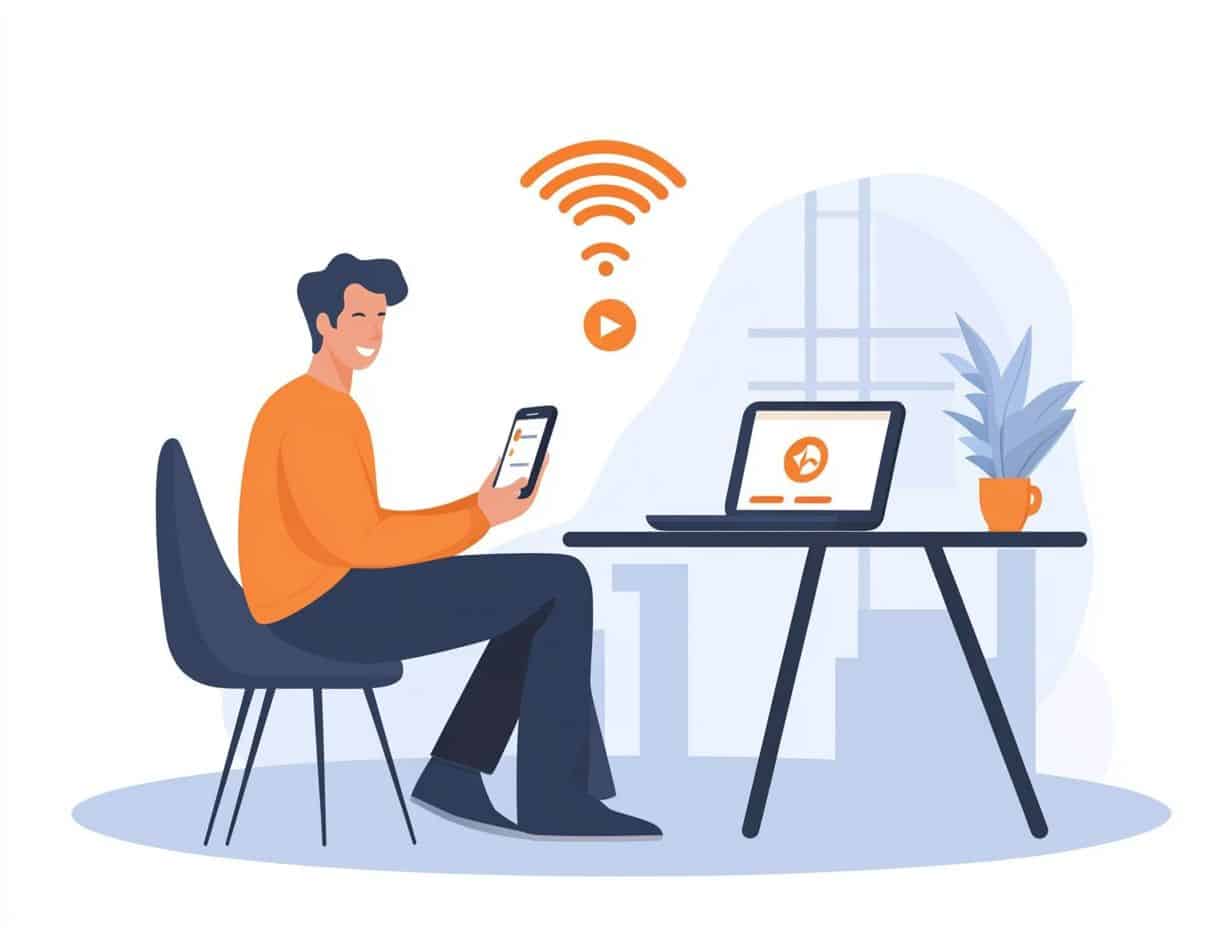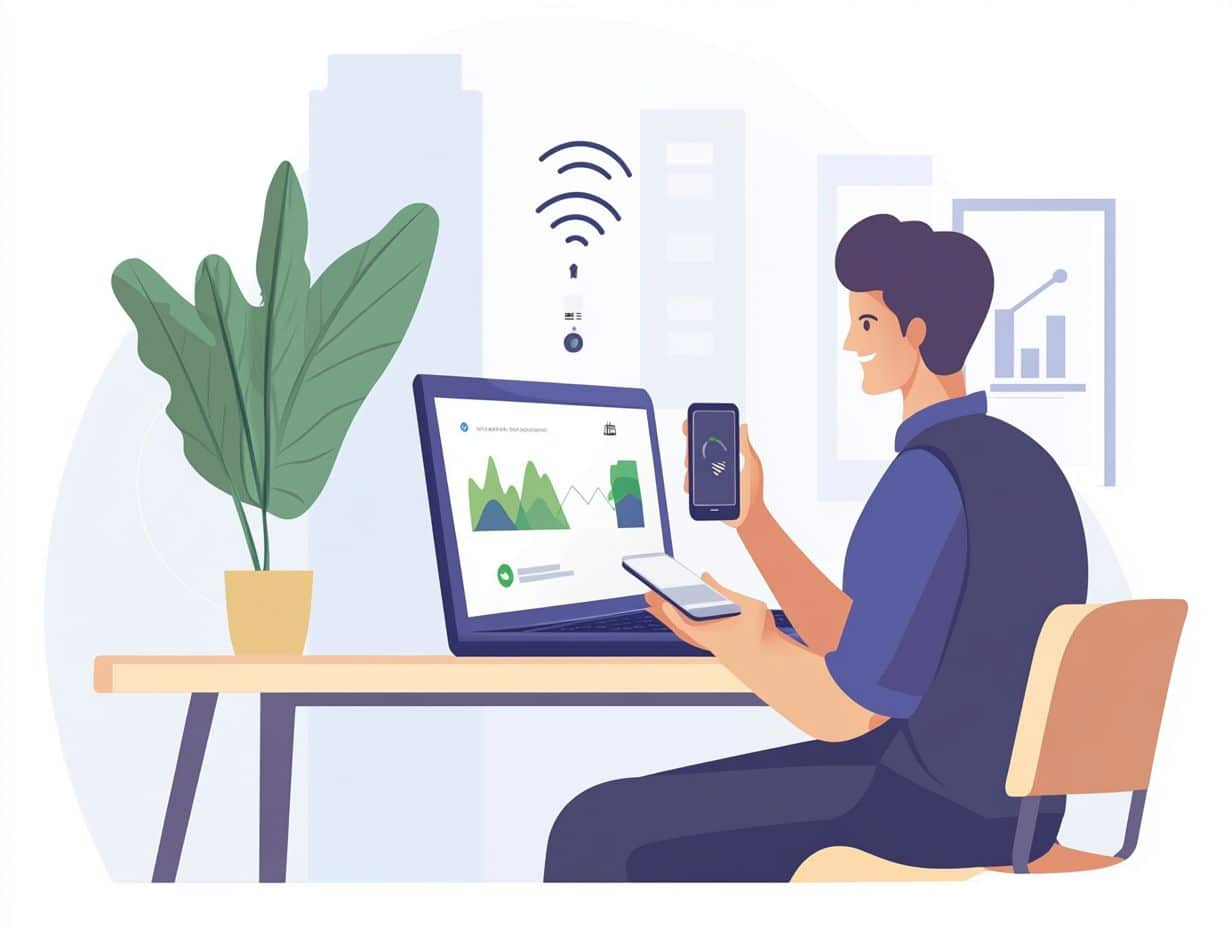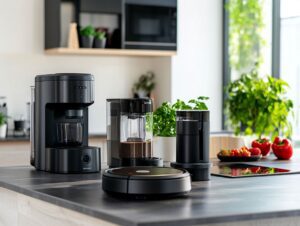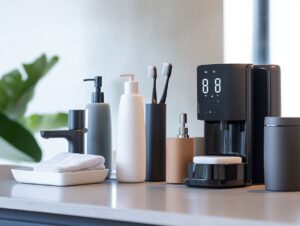I find that staying connected is super important, and mobile hotspots have become my go-to solution for internet access on the move. So Making Your Hotspot Faster is important!
So, what exactly is a hotspot, and what really affects its speed?
I m diving into the factors that influence internet speed and sharing some practical tips to boost it. From tweaking device settings to troubleshooting those pesky common issues, I ll show you how to maximize hotspot performance and make the most of your data usage.
Stick around to discover the secrets to a faster, more reliable connection!
Understanding Hotspots and Internet Speed

I ve found that understanding hotspots and internet speed is super important for anyone wanting to make the most of their online experience, especially since we all rely so much on Wi-Fi and mobile data for smooth connectivity.
A hotspot lets multiple devices connect to the internet using just one data plan, basically turning my smartphone or router into a mini access point.
But there are a bunch of factors that can affect my internet speed, like bandwidth, latency, and signal strength. So, it s really key to wrap my head around these concepts if I want to boost my network performance.
Let s take a closer look at what a hotspot is and how it impacts my internet usage.
What is a Hotspot and How Does it Work?
A hotspot, in simple terms, is just a physical spot where I can connect to the internet via Wi-Fi. This is usually set up by a mobile hotspot device or a router. These hotspots allow my devices to tap into the internet using mobile data or broadband connections, effectively turning them into a little access point for others. It s super handy, especially when I m traveling or if my home Wi-Fi decides to take a day off. Understanding how hotspots work helps me get the most out of my internet experience.
The technology behind mobile hotspots relies on cellular networks that send out data signals, which my devices can connect to wirelessly. Tethering is another cool feature that lets my smartphone act as a hotspot by sharing its mobile data with other devices.
There are different types of hotspots, like the public ones I find in caf s or airports that anyone can use. Then there are private hotspots, usually created with personal devices, which offer a more secure connection tailored just for me. Knowing the differences between these types helps me choose the best and safest connection options for what I need.
Factors that Affect Internet Speed
There are quite a few factors that can really affect my internet speed, and it’s super important to get a grasp on them for a smoother experience. Internet speed isn t just about the bandwidth my ISP offers; it also involves things like latency, which measures how long it takes for data to start transferring, and signal strength, which can change based on how far I am from the router or if there s any interference nearby. Plus, network congestion and device compatibility can throw a wrench in my connectivity performance, so knowing how these elements play into my user experience is key.
The way these factors interact can create a pretty tangled web of influences on overall performance. For instance, I might have high bandwidth that promises fast download speeds, but if latency is high, I ll still be stuck waiting for web pages to load or videos to stream. And when multiple devices are connected to the same network, they end up competing for that precious bandwidth, which leads to network congestion and slows everything down for everyone. If the signal strength is weak because of walls or distance from the router, even the fastest internet plan can feel like it’s dragging its feet.
Getting a handle on these dynamic relationships really helps me troubleshoot connection issues more effectively.
Ways to Improve Hotspot Speed
Improving my hotspot speed can really boost my internet experience, especially when I’m relying on mobile data or a mobile hotspot device. There are plenty of strategies I can use to optimize hotspot performance, like tweaking my network settings or using external hardware like signal boosters or network extenders.
I also like to run speed tests to pinpoint areas where I can improve, making sure my connection stays stable and efficient. Let s dive into some effective methods to enhance my hotspot speed.
Optimizing Device Settings
Optimizing my device settings is one of the easiest yet most effective ways I ve found to boost hotspot speed. By tweaking network settings like enabling Quality of Service (QoS) or making sure my firmware is up-to-date I can prioritize bandwidth for the apps that really matter and enhance overall performance.
I also like to optimize the apps that use up a lot of data, which helps me manage my hotspots better and keep my connection stable for all my devices. Let s dive into how I can fine-tune my device settings.
One practical way I use QoS is by giving priority to video conferencing or online gaming apps since they need a more stable connection. I usually find the QoS settings in the network or advanced settings menu on my devices. After enabling these settings and switching the Wi-Fi frequency to a less crowded band, like 5 GHz, I ve noticed a real boost in speed and reliability.
I also think about uninstalling or restricting background apps that constantly sync data because that can free up some much-needed bandwidth. Regularly clearing the cache or updating my apps can lead to a smoother performance, making sure my hotspot use stays effective and user-friendly.
Using Signal Boosters and Extenders

Using signal boosters and network extenders has really helped me boost my hotspot’s performance, especially in those spots where the signal is weaker than a paper umbrella in a rainstorm. These devices take my existing signal and amplify it, which not only expands my coverage area but can also skyrocket my download and upload speeds. If I find myself in a place with consistently weak Wi-Fi, I know that investing in external antennas or a dedicated signal booster can make a huge difference in my connectivity. Let s dive into how these tools can work wonders for me.
When used well, signal boosters and network extenders turn my internet experience into something reliable and solid, filling in the gaps where signals usually struggle. They grab those weak signals and spread them around, giving me seamless connectivity for multiple users and cutting down on latency. That s a game changer for things like video streaming or online gaming.
For anyone running a business in a remote location or living in a rural area like me, having that enhanced coverage can make everything run smoother and boost productivity. Plus, with so many models out there, from compact devices for personal use to powerful systems for larger spaces, there s definitely a solution that fits every unique need.
Switching to a Different Carrier or Plan
Sometimes, I find that the best way to boost my hotspot speed is to switch to a different carrier or data plan that really fits my needs. Not all ISPs are created equal; some might throttle my speed during peak hours, leading to those annoying connectivity issues.
It s super important to explore various options because each carrier has a different way of handling data limits and prioritizing network traffic. For example, one provider might have strict data caps, which means I could experience slower speeds once I hit my monthly limit. Meanwhile, another provider might offer unlimited data with a more stable connection.
I also like to check out customer reviews to see how others feel about performance changes and service reliability. By taking all these factors into account like contract terms and any hidden fees I can make a more informed decision that ll ultimately give me a better mobile internet experience.
Maximizing Hotspot Data Usage
Maximizing my hotspot data usage is super important, especially since I rely on mobile data for my internet needs and have those pesky data limits. If I manage my data consumption efficiently, I can stretch my usage and really get the most out of my hotspot.
By tweaking my APN settings and keeping an eye on which apps I use, I can cut down on unnecessary data consumption and keep my internet connection stable. Let s dive into how I can effectively manage my hotspot data usage.
Managing Data Consumption
Managing data consumption is super important for getting the most out of my hotspot and making sure I don t blow past my data limits. By keeping an eye on my usage patterns and figuring out which apps chew up the most data, I can make smarter choices about how to use my hotspot resources. Hotspot management tools are a lifesaver they let me track my data consumption in real-time, so I can adjust my habits as needed. Let s dive into some strategies for managing data consumption effectively.
It s crucial to know which apps or services are responsible for high data usage if I want to optimize performance. I love using the built-in analytics features on my device; they really help me see which applications are draining my data the quickest.
I ve also started using data-saving modes on my smartphone, which are great for limiting background data usage and focusing on the essentials. Plus, setting data alerts in my hotspot management apps keeps me in the loop before I hit my limits.
By adopting these strategies, I not only manage my data consumption better but also boost the overall performance of my hotspot, making my internet access smoother and way more reliable.
Conserving Data with Settings and Apps
Conserving data while using my hotspot has been a total game changer, especially since I m on a limited data plan. By optimizing my network settings and tweaking my apps, I ve managed to cut down on data usage without sacrificing performance. Utilizing bandwidth management has played a key role in this.
|||
Conserving data while using my hotspot has been a total game changer, especially since I m on a limited data plan. By optimizing my network settings and tweaking my apps, I ve managed to cut down on data usage without sacrificing performance. Utilizing bandwidth management has played a key role in this, allowing me to prioritize connected devices.
Conserving data while using my hotspot has been a total game changer, especially since I m on a limited data plan. By optimizing my network settings and tweaking my apps, I ve managed to cut down on data usage without sacrificing performance.
I ve found that monitoring my data consumption through my device settings is super important; most smartphones have built-in tools that show how much data each app is using. I like to activate options that limit background data, which helps keep those sneaky apps from munching on my precious resources when I’m not actively using them.
Turning off auto-play for videos and reducing the quality on streaming services has also helped a lot. I ve even explored my device s data saver mode for a more tailored approach, which helps me manage my overall usage more efficiently. By being proactive about app permissions and notifications, I can better protect my data limits and enjoy uninterrupted connectivity.
Troubleshooting Common Hotspot Issues

Troubleshooting common hotspot issues is super important for keeping my internet connection stable and making the most of my mobile data. Whether I’m dealing with connectivity problems, slow internet speeds, or signal strength that seems to have a mind of its own, knowing how to do some effective network diagnostics really saves me from a lot of frustration. Using a Wi-Fi analyzer can also help in identifying issues.
|||
Troubleshooting common hotspot issues is super important for keeping my internet connection stable and making the most of my mobile data. Whether I’m dealing with connectivity problems, slow internet speeds, or signal strength that seems to have a mind of its own, knowing how to do some effective network diagnostics really saves me from a lot of frustration. Using a Wi-Fi analyzer can also help in identifying issues and optimizing the hotspot location.
Troubleshooting common hotspot issues is super important for keeping my internet connection stable and making the most of my mobile data. Whether I’m dealing with connectivity problems, slow internet speeds, or signal strength that seems to have a mind of its own, knowing how to do some effective network diagnostics really saves me from a lot of frustration.
I can analyze my network settings and run speed tests there are plenty of troubleshooting steps that can help. Let s dig into some of those common hotspot hiccups and figure out how to fix them.
Addressing Connectivity Problems
Addressing connectivity problems can sometimes feel like a daunting task, but once I understand the key factors, it becomes a lot easier. Common issues like poor signal strength, network interference, and being too far from my router can lead to those frustrating connection drops. By pinpointing these problems, I can take specific troubleshooting steps to get my connection back on track. Let s dive into how to tackle these connectivity hiccups effectively using network optimization techniques.
|||
Addressing connectivity problems can sometimes feel like a daunting task, but once I understand the key factors, it becomes a lot easier. Common issues like poor signal strength, network interference, and being too far from my router can lead to those frustrating connection drops. By pinpointing these problems, I can take specific troubleshooting steps to get my connection back on track. Let s dive into how to tackle these connectivity hiccups effectively using network optimization techniques, considering factors like distance and signal strength.
Addressing connectivity problems can sometimes feel like a daunting task, but once I understand the key factors, it becomes a lot easier. Common issues like poor signal strength, network interference, and being too far from my router can lead to those frustrating connection drops. By pinpointing these problems, I can take specific troubleshooting steps to get my connection back on track. Let s dive into how to tackle these connectivity hiccups effectively.
I ve realized how important it is to pay attention to my surroundings because various obstacles can seriously mess with my signal quality. Things like walls, furniture, and even electronic devices can block or disrupt those precious signals.
I ve found that checking for bandwidth hogs like multiple streaming devices or big downloads can help me figure out why my connection is lagging.
Some simple yet effective strategies I like to use include implementing a strong quality of service setting:
- Repositioning the router to a better spot
- Limiting the number of active connections
- Adjusting the antennas to boost the range
- Using a VPN for additional security
|||
- Repositioning the router to a better spot
- Limiting the number of active connections
- Adjusting the antennas to boost the range
- Using a VPN for additional security
- Repositioning the router to a better spot
- Limiting the number of active connections
- Adjusting the antennas to boost the range
By addressing these factors with targeted actions, I can really enhance my connectivity experience.
Solving Slow Internet Speeds
Solving slow internet speeds is super important for anyone like me who relies on a hotspot for connectivity. There are all sorts of things that can slow things down, like not having enough bandwidth or dealing with network congestion.
|||
Solving slow internet speeds is super important for anyone like me who relies on a hotspot for connectivity. There are all sorts of things that can slow things down, like not having enough bandwidth or dealing with network congestion. Factors such as signal interference can also play a role.
Solving slow internet speeds is super important for anyone like me who relies on a hotspot for connectivity. There are all sorts of things that can slow things down, like not having enough bandwidth or dealing with network congestion.
The first thing I do to tackle these issues is run a speed test. It s a simple step, but it gives me a clear picture of my current upload and download speeds, highlighting any discrepancies from what I should be getting. If the results are consistently underwhelming, it might mean I m hitting some bandwidth limits or that background apps are hogging my resources.
I also take a look at how many devices are connected to my network. Too many connections can really drag down my speed. By addressing these factors one by one, I can seriously improve my internet experience and get my hotspot running at its best.
Frequently Asked Questions
How to make your hotspot faster?
|||
How to make your hotspot faster?

To make your hotspot faster, try the following steps:
|||
To make your hotspot faster, try the following steps to enhance your mobile data experience:
- Move closer to your phone or device that is being used as the hotspot
- Reduce the number of connected devices to the hotspot
- Restart your phone or device
- Check for software updates on your phone or device
- Reset your network settings
- Upgrade your data plan with your service provider
How to make your hotspot faster?
To make your hotspot faster, try the following steps:
- Move closer to your phone or device that is being used as the hotspot
- Reduce the number of devices connected to the hotspot
- Restart your phone or device
- Check for software updates on your phone or device
- Reset your network settings
- Upgrade your data plan with your service provider
Can I improve my hotspot speed without changing my data plan?
Yes, there are a few ways to improve your hotspot speed without changing your data plan:
|||
Yes, there are a few ways to improve your hotspot speed without changing your data plan, focusing on network optimization:
- Try using a different hotspot app
- Change the channel and frequency settings on your phone or device
- Invest in a signal booster or extenders
- Use a wired connection instead of Wi-Fi
Yes, there are a few ways to improve your hotspot speed without changing your data plan:
- Try using a different hotspot app
- Change the channel and frequency settings on your phone or device
- Invest in a signal booster or extenders
- Use a wired connection instead of Wi-Fi
Why is my hotspot slow even though I have a strong signal?
There are a few reasons why your hotspot may be slow even with a strong signal:
|||
There are a few reasons why your hotspot may be slow even with a strong signal, including:
- Too many devices connected to the hotspot
- Network congestion or high traffic in your area
- Outdated software on your phone or device
- Data throttling from your service provider, affecting upload speed and download speed
There are a few reasons why your hotspot may be slow even with a strong signal:
- Too many devices connected to the hotspot
- Network congestion or high traffic in your area
- Outdated software on your phone or device
- Data throttling from your service provider
Can I use my phone or device as a hotspot for gaming?
Yes, you can use your phone or device as a hotspot for gaming, but it may not provide the best experience. To improve gaming on a hotspot, try these tips:
|||
Yes, you can use your phone or device as a hotspot for gaming, but it may not provide the best experience. To improve gaming on a hotspot, try these tips that focus on reducing latency:
- Choose a location with good signal and low network congestion
- Limit the number of devices connected to the hotspot
- Use a wired connection if possible
- Consider upgrading to a higher data plan for faster speeds
Yes, you can use your phone or device as a hotspot for gaming, but it may not provide the best experience. To improve gaming on a hotspot, try these tips:
- Choose a location with good signal and low network congestion
- Limit the number of devices connected to the hotspot
- Use a wired connection if possible
- Consider upgrading to a higher data plan for faster speeds
Is there a way to track how much data my hotspot is using?
Yes, you can track your hotspot data usage by checking your phone or device’s data usage settings or using a third-party data tracking app. This can help you monitor your usage and avoid going over your data limit by keeping an eye on data efficiency.
|||
Yes, you can track your hotspot data usage by checking your phone or device’s data usage settings or using a third-party data tracking app. This can help you monitor your usage and avoid going over your data limit by keeping an eye on data efficiency and hotspot features.
Yes, you can track your hotspot data usage by checking your phone or device’s data usage settings or using a third-party data tracking app. This can help you monitor your usage and avoid going over your data limit.
Will using a hotspot drain my phone’s battery?
Yes, using a hotspot can drain your phone’s battery faster than normal. To conserve battery life, try these tips:
|||
Yes, using a hotspot can drain your phone’s battery faster than normal. To conserve battery life while maximizing mobile hotspot performance, try these tips:
- Use a wired connection instead of Wi-Fi
- Turn off your hotspot when not in use
- Lower the brightness and turn off unnecessary features on your phone or device
- Use a portable charger to keep your phone or device charged
Yes, using a hotspot can drain your phone’s battery faster than normal. To conserve battery life, try these tips:
- Use a wired connection instead of Wi-Fi
- Turn off your hotspot when not in use
- Lower the brightness and turn off unnecessary features on your phone or device
- Use a portable charger to keep your phone or device charged






